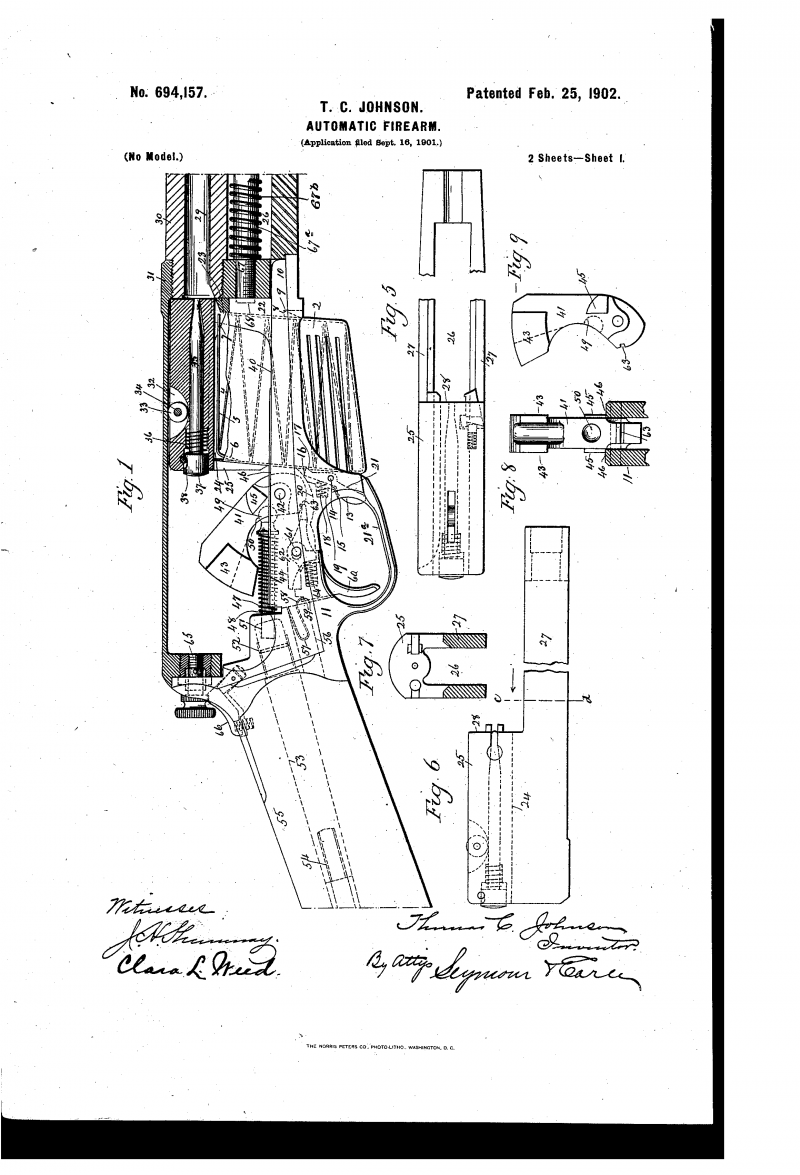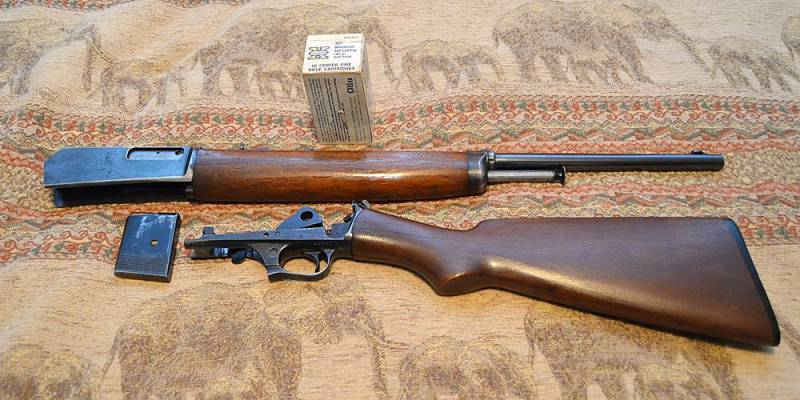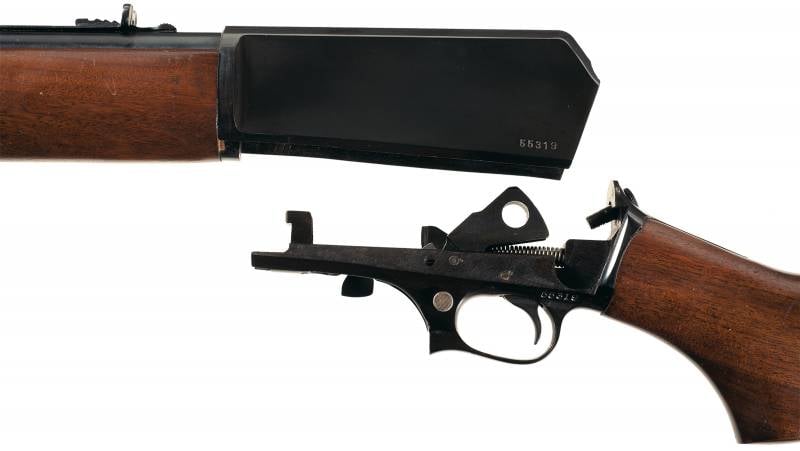Self-loading rifle Winchester Model 1907 (USA)
Recall that the first Winchester self-loading rifles were developed by the designer Thomas Crossley Johnson. At the very beginning of the 20th century, he proposed a new design of automation based on a free slide, which later became the basis for several serial rifles. The development of the original project was carried out by making certain changes, as well as through the creation and introduction of new cartridges. It is noteworthy that at the heart of the M1907 project lay exactly a new type of ammunition.
The M1905 rifle is available in .32 Winchester Self-Loading and .35 WSL versions. These munitions ensured the correct operation of the automation, but did not differ in high power: the muzzle energy of the .35 caliber did not exceed 1050 J, which was not enough to hunt some species of game. Wanting to please the gunmen-hunters, Winchester took up the creation of a new reinforced cartridge and weapons for its use.
Based on the .35 WSL cartridge, the .351 WSL munition was developed. The length of the liner was increased from the original 29,3 mm to 34,9 mm, and the weight of the propellant charge also increased proportionally. 12-gram bullet remained without significant changes. The new cartridge, thanks to a more powerful powder charge, was distinguished by increased parameters. The initial speed of the bullet (using the 20-inch barrel) increased to 570 m / s, and the muzzle energy reached 1900 J.
A new ammunition was supposed to be a modified version of the existing one. By the same principle, it was proposed to build a new rifle, which received the designation Model 1907. From the point of view of design, it should have been a modified M1905 with different chamber sizes and springs, the parameters of which corresponded to the new cartridge of increased power. Other details of weapons, as well as the principles of the mechanisms, could remain unchanged.
The new project retained the overall layout of the product with the use of a long barrel, under which were placed a wooden forearm and reload rod. The main element of the weapon was to be a metal receiver, to which the butt was attached to the back. The Model 1907 rifle was supposed to retain the characteristic feature of its predecessors as disassembly capability. The receiver box of the product consisted of two parts fastened together with other units. By removing the rear locking screw, the rifle could be disassembled into two parts, which simplified its transportation.
The receiver was divided into two parts: the upper casing of the U-shaped cross section and the L-shaped lower frame. Inside the upper casing, it was proposed to leave the bolt and its systems, and its front wall had a set of holes to accommodate the barrel, bolt and other parts. The bottom frame was the basis for mounting the firing mechanism. On the outer surface of the frame, there was only a trigger bracket, a magazine latch and attachment for a butt. Detachable stores were proposed to be placed in the window at the bottom of the trigger frame.
The complicated form of the shutter remained the same, which, however, had to be a little heavier to maintain working capacity with a more powerful cartridge. The shutter was a piece of complex shape with a set of internal cavities for the drummer and its spring, as well as for mounting the extractor sleeve. The shutter was connected to the oblong frame of the U-shaped profile. This part passed through a hole in the front wall of the receiver and was placed inside the cavity between the forend and barrel. There was also a compression spring, which was connected to a support on the trunk and the front part of the bolt carrier.
The unusual recharge system has not changed. For cocking the mechanisms of weapons before shooting, it was proposed to use an oblong rod placed under the barrel. When you press the rod had to go inside the forearm and put pressure on the bolt carrier. He returned to the neutral position with his own return spring.
The Model 1907 rifle received a barrel length of 20 inches (mm 510 or 57 gauges). The barrel was rigidly connected to the receiver, and its lower part was covered with the forearm, which served to protect the hands of the shooter. Also on the trunk provided space for the installation of sights.

Cartridge .351 Winchester Self-Loading. Photo Armoury-online.ru
The rifle received a trigger type trigger. Its main detail was a large swinging trigger, connected to the mainspring and capable of blocking in the cocked position with the aid of a yoke-whisper. The latter was in contact with the trigger. Like the rifles of previous models, the M1907 had to be equipped with a non-automatic safety device. Pressing the button located in the trigger bracket stand blocked the trigger, preventing the shot from being fired.
The rifle ammunition system was based on detachable box stores, which were an enlarged version of existing products. At first, the 5 351 WSL cartridge magazine was offered. A little later, an enlarged store appeared with twice the capacity. In its place, the store was fixed with a latch. The two types of stores had some differences in terms of ergonomics. So, the bottom of the small one was at the level of the trigger guard, whereas the magazine for 10 cartridges was seriously lower.
At the rear of the barrel fit adjustable mechanical sight. Also the trunk was equipped with guides for a mobile front sight. At the request of the customer, the rifle could receive, instead of an open sight, a ring-type system.
The fittings of the new rifle were borrowed without significant changes from the existing samples. Under the barrel mounted forearm, in the back - butt with a pistol protrusion. As in the case of the previous self-loading rifles, Winchester offered two finishes to customers. In the version of Plain finish, lacquered walnut wood fittings with smooth surfaces were used. Option Fancy finish got a handguard and pistol protrusion with a notch for a more comfortable hold. The finish of metal parts was also different.
The Winchester Model 1907 rifle had a total length of about 1 m and weighed no more than 4,1 kg. Depending on the series and year of release, the size and weight of the product could vary slightly. In addition, in the future, a special modification of the rifle appeared, which had even more serious differences from the basic weapon.
Despite the use of the new cartridge, in terms of how the rifle operates, the M1907 was almost an exact replica of the previous M1905. The use of a more powerful patron made TK Johnson used heavy bolt and reinforced springs, but the general scheme and principle of operation of automation remained the same. As before, the weapon had to use a recoil impulse for reloading, leading to the movement of the free gate.
Equipping the store and placing it in the receiving window, the shooter had to cock the weapon with the help of a rod under the barrel. At the same time, the valve was retracted, cocked, and the cartridge was loaded and discharged into the chamber. After turning off the manual fuse, the rifle was ready to fire.
Pressing the trigger led to the release of the trigger, which, under the action of the mainspring, turned on its axis and hit the bolt strike. Shot occurred. Under the effect of recoil, the bolt rolled back, grabbing and removing the cartridge case from the chamber. In addition, the shutter frame compressed the return spring. When moving back the bolt threw the sleeve through the window in the receiver and pressed the trigger to the lowest position in which it was blocked with the help of a whisper.
After the cessation of recoil, the recoil spring was pulled forward, which caused the next cartridge to be captured and then sent to the chamber. The return of the bolt to the extreme front position was the completion of the automation cycle and allowed for a new shot.
In 1907, a new rifle went into series and was offered to buyers. Weapons could interest shooters, which led to the emergence of new orders. Due to the use of a more powerful cartridge with an almost twofold superiority in the muzzle energy, the rifle Model 1907 was of greater interest for hunters and shooters-athletes. In addition, there was a certain opportunity to interest new customers in the face of the military departments of various countries.
The military orders of several countries are perhaps the most interesting events in stories rifle Winchester Model 1907. After the outbreak of the First World War, several countries began to search for new weapons for their armies, which, among other things, led to the conclusion of contracts for the supply of M1907-type products and .351 WSL cartridges. During the war years, in the interests of several armies, about 5740 rifles and several million rounds of ammunition were fired.
As you know, the first such customer of the M1907 rifles was the Royal Flight Corps of Great Britain (the future Royal Air Force). At the end of 1914, the British military aviation ordered 120 Model 1907 rifles and 78 thousand cartridges for them. Deliveries of this weapon continued until April 1916. In the future, for a number of reasons, it was necessary to abandon the M1903 rifles and order M1903 products of the same company with the corresponding ammunition. In this case, six hundred rifles were ordered.
The Royal Air Corps considered the new rifles as weapons for observer pilots, which should be used to solve various tasks, primarily for self-defense. Thus, thanks to the new weapon, the observers also became gunners. Winchester self-loading rifles remained the standard armament of two-seater aircraft until more powerful and effective systems appeared.
In the fall of 1915, France ordered the M300 rifles from American gunsmiths 1907. Soon followed a second order for 2500 weapons. In addition, before 1917, Winchester was supposed to deliver 1,5 million cartridges. The execution of two orders did not take long. Subsequently, the French army placed several more orders.
The result of two Franco-American orders from 1917 and 1918 was the development of an upgraded rifle. Products with the Model 1907 / 17 symbol have received a modified trigger mechanism with the possibility of automatic firing. In addition, such a weapon received barrels with fastenings for a bayonet from a Lee-Navy rifle, and was also completed with box magazines for 15 and 20 cartridges. The upgraded weapon differed from the base rifle in the possibility of firing bursts at a pace to 650-700 shots per minute. In total, the customer received an 2200 automatic rifle.
In May, the Russian Empire ordered the 1916 of the year from the American company JP Morgan Company a batch of 500 Model 1907 rifles with an ammunition in 1,5 million cartridges. In addition, this agreement stipulated the supply of weapons and ammunition of other types. Self-loading rifles of a new type were delivered to the customer and soon dispersed in parts that were on the front. Unfortunately, there is no detailed information on the use of such rifles. Nevertheless, it can be assumed that in some situations, the M1907 systems showed good results and advantages over regular Trilineers, while in other cases a less powerful cartridge led to a conditional loss.
At the beginning of the 1930s, against the background of rampant crime, US law enforcement agencies showed great interest in small arms of various classes and types. Together with other samples, some Winchester Model 1907 rifles were purchased by some police departments and the Federal Bureau of Investigation. In the case of the FBI, an order for self-loading rifles and other automatic weapons appeared after the so-called. shot in Kansas City. 17 June 1933, bandits armed with automatic weapons, shot four officers who did not have such powerful weapons. One of the results of this incident was an order for automatic and self-loading systems, including Model 1907.
In the 1935 year, after another order from law enforcement agencies, the Winchester Repeating Arms Company developed and presented a special version of the M1907 rifle, which was designated the Police Rifle ("Police Rifle"). This rifle differed displaced unregulated sight, received an enlarged magazine latch button, and also had a modified barrel with a different muzzle part and attachments for the bayonet. The latter was borrowed from the Springfield Model 1892-99 rifle (the American version of the Norwegian Krag-Jørgensen rifle).
Model 1907 rifles of several versions with different finishes and various design features were made before the 1957 year. For half a century, a significant number of rifles were assembled and sold. According to some data, during the last decades rifles of the “police” version, which were of great interest for various power structures, were in special demand. The original “civilian” rifles were also selling well and were widely used by amateur arrows and hunters.
The Winchester Model 1907 self-loading rifle was a further development of the ideas proposed by TK. Johnson at the very beginning of the 20th century. For several years, the gunsmith repeatedly changed and modified the original design, and also created new ammunition for use with it. Original ideas made it possible to create a whole family of autoloading weapons with quite high characteristics. At the same time, the characteristic disadvantage of all these samples was the use of their own patron, which did not quite suit some potential buyers. However, the developers of new weapons considered this strategy to be correct, and continued the development of self-loading rifles in the chosen direction. For the next family of weapons, which received the designation Model 1910, a new cartridge of the Winchester Self-Loading line was developed again.
On the materials of the sites:
//historicalfirearms.info/
//armoury-online.ru/
//militaryfactory.com/
//oldschoolguns.blogspot.ru/






Information